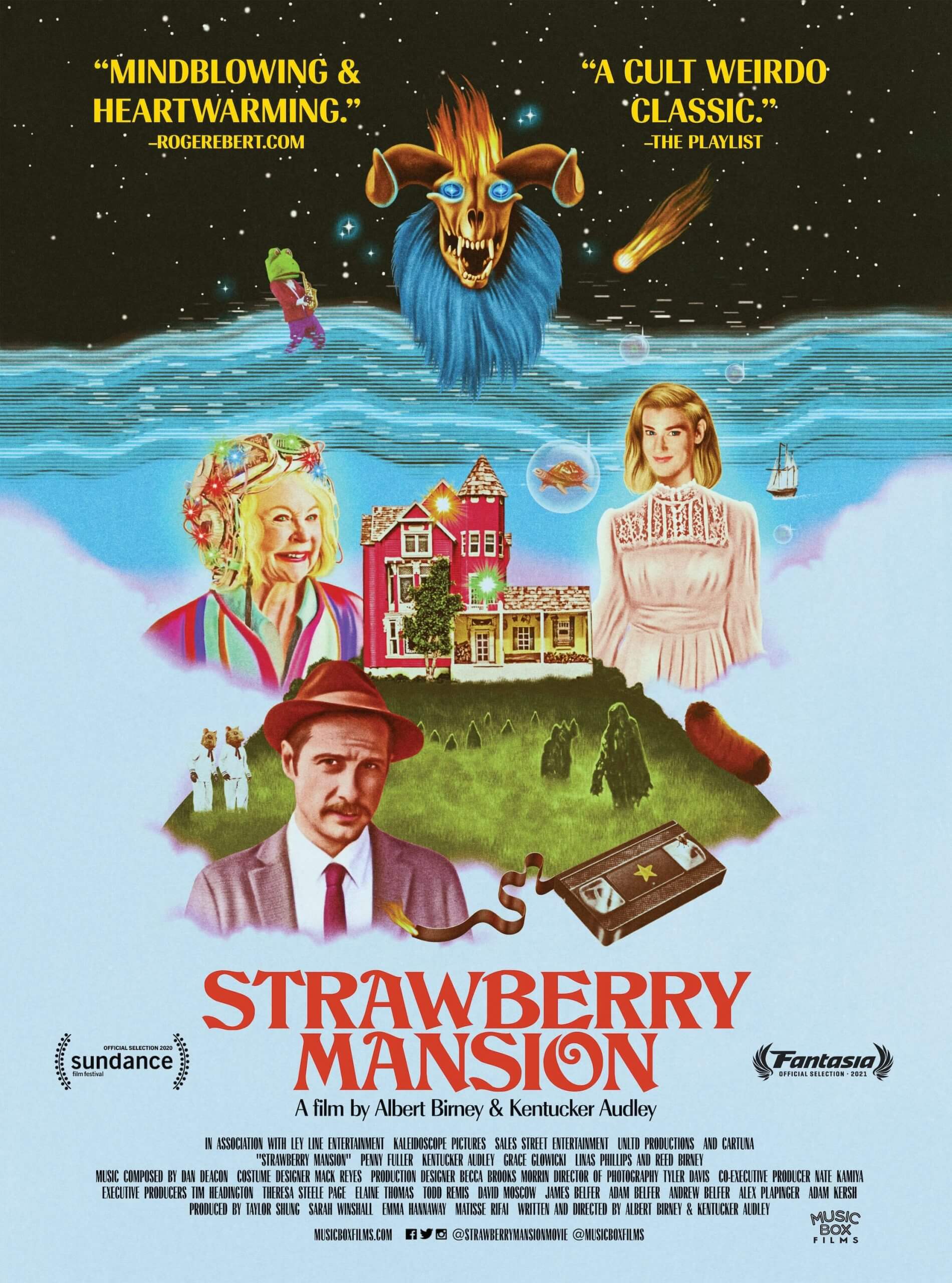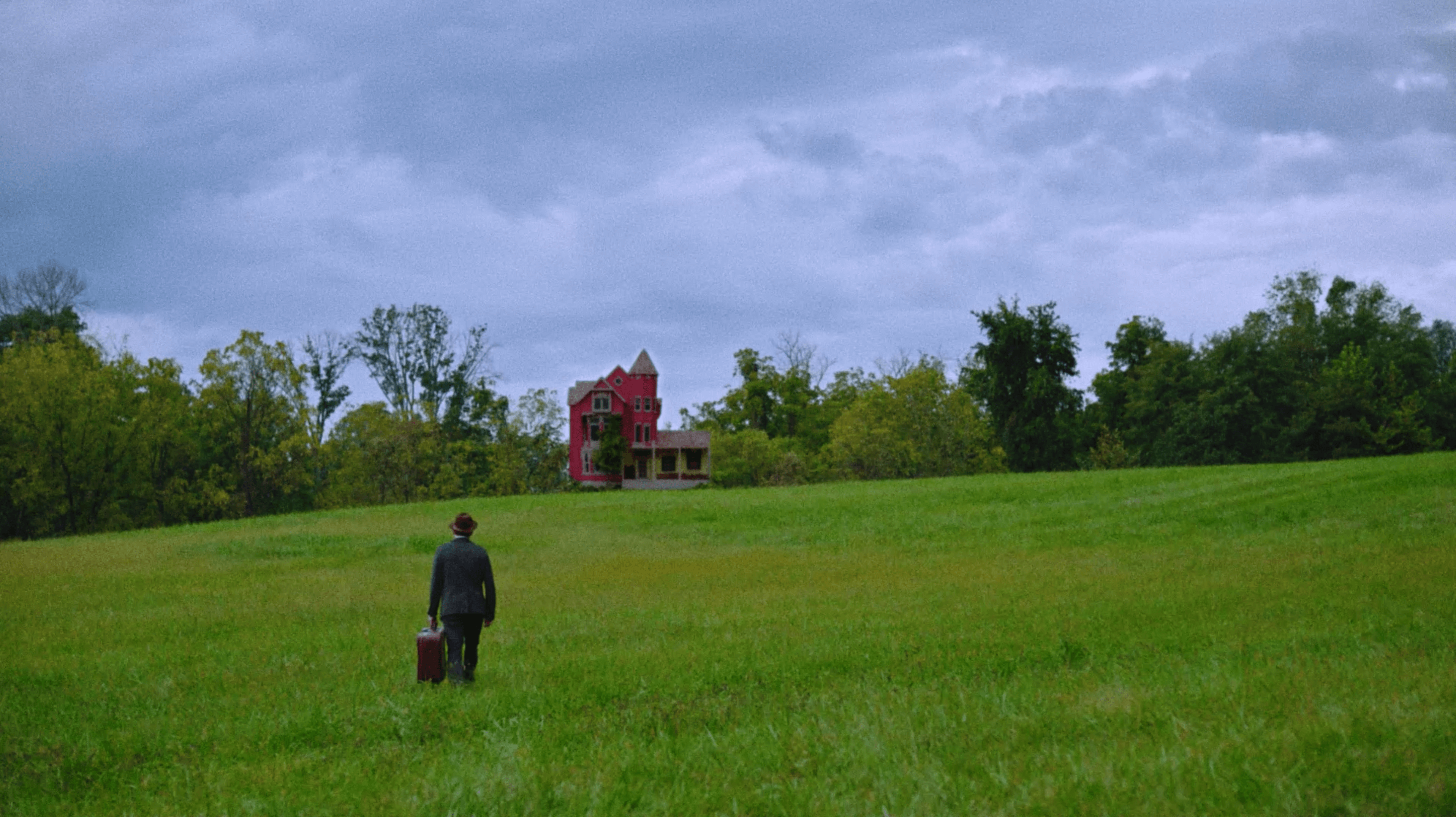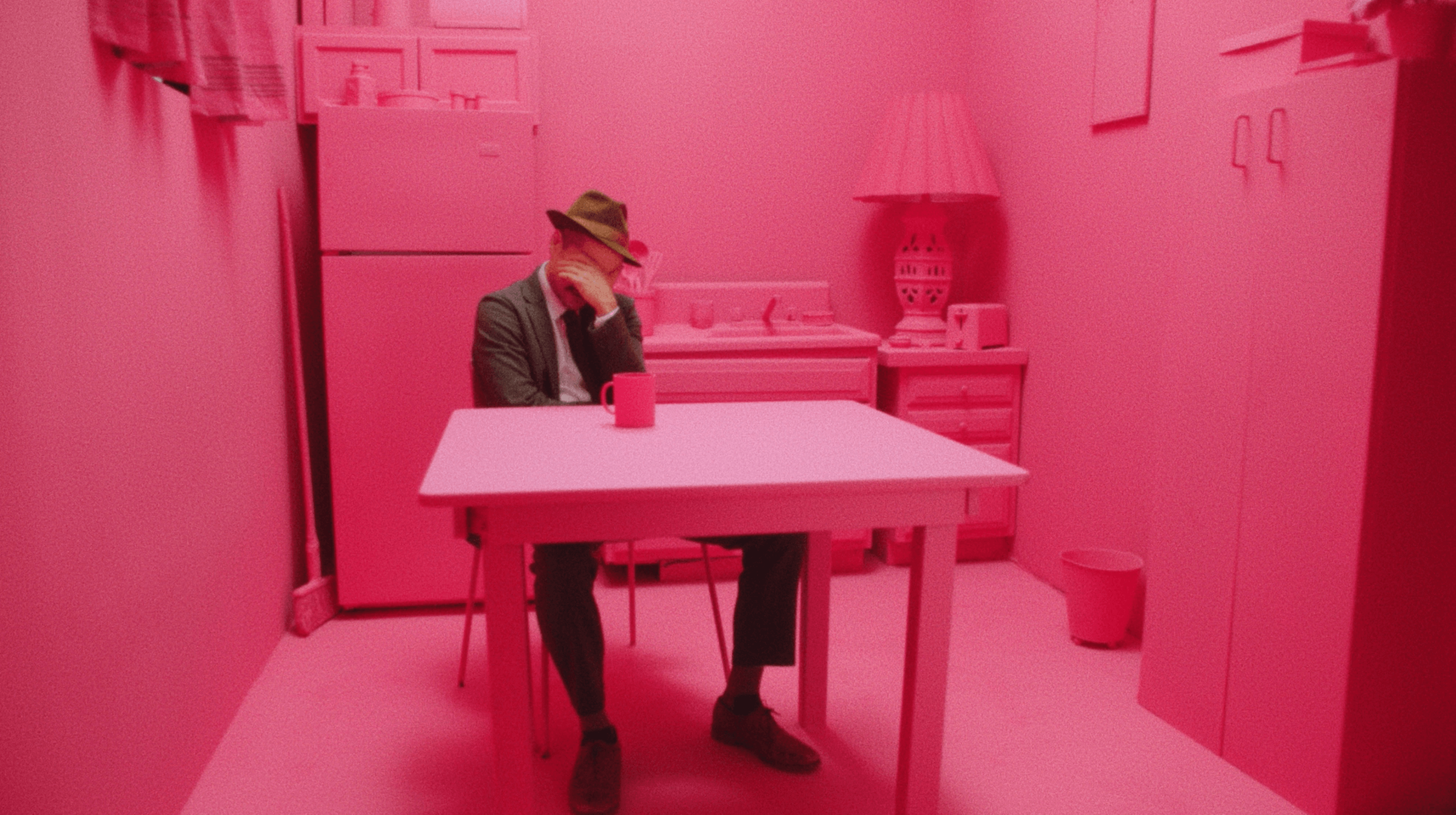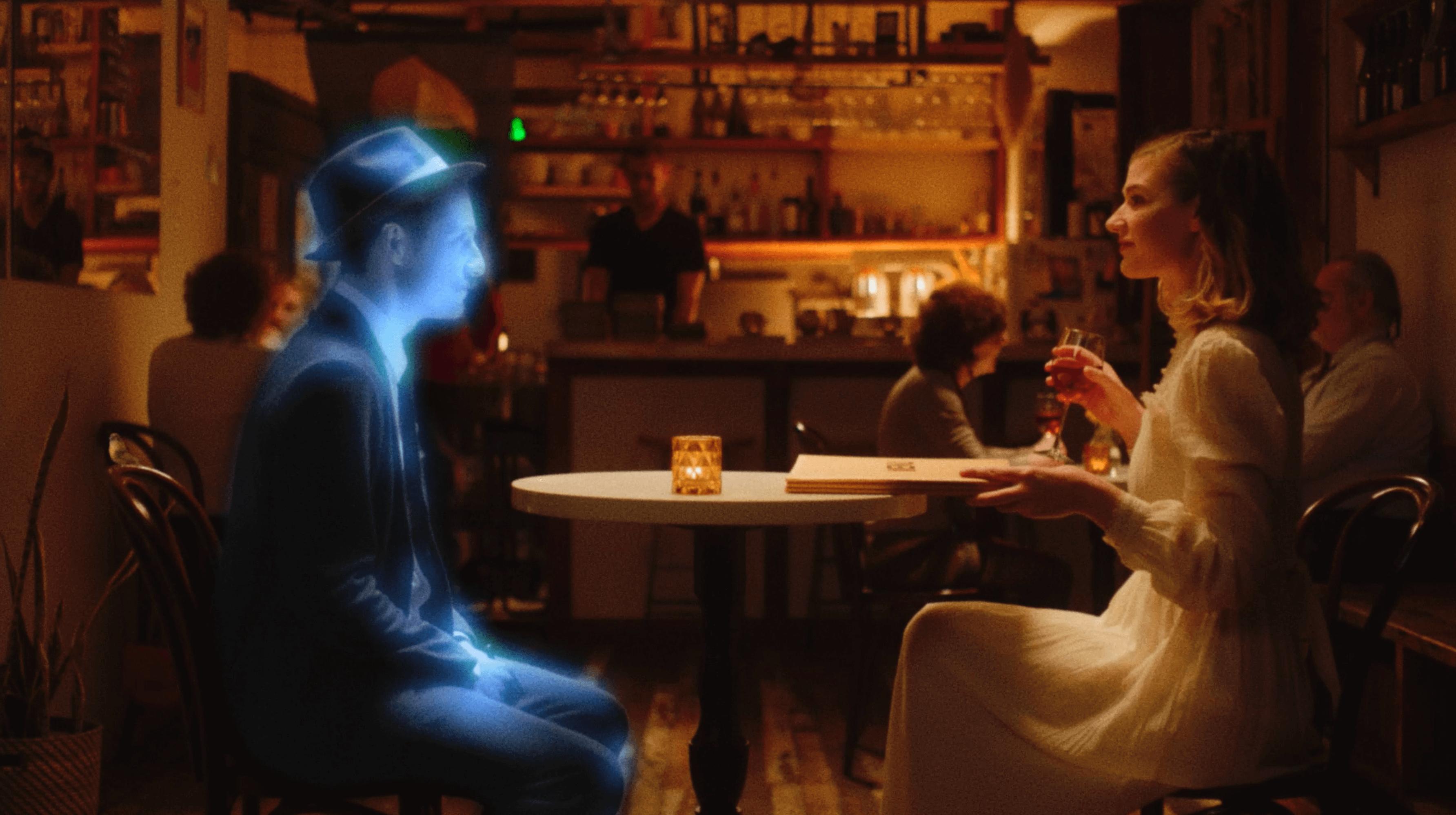On curiosities, collaboration and independent filmmaking: A talk with Albert Birney and Kentucker Audley

Strawberry Mansion is a fantasy film set in 2035, following the curious journey of dream auditor and taxman James Preble (played by writer-director Kentucker Audley). The film shifts through time, visions and dreams and touches upon themes of mass surveillance, advertising, unconsciousness and love. The film premiered at the 2021 Sundance Film Festival and was nominated for the NEXT Innovator Award.
Co-writers and directors Albert Birney and Kentucker Audley joined the virtual interview wearing turquoise coloured matching shirts from two different rooms through two different computer scenes to discuss their second feature film as collaborators. Sylvio (2017), their first directorial collaboration, debuted at SXSW and was named one of the Best 10 Movies of The Year by The New Yorker.
FRONTRUNNER speaks with Birney and Audley about the logic and confusion behind dreams, treasures on VHS tapes and childhood fantasies, as well as film festivals and the importance of fun in filmmaking.

How did you come up with the idea for the film and what was the writing process like?
Albert Birney: The initial idea was to make the type of movie that you would want to discover. Thinking a lot about being a kid and being in the video store on a Friday night browsing the wall of VHS videotapes. What would the movie that I would have loved to have found when I was that age be and think backwards from that. A lot of those movies that we both grew up watching were very fantastic. [They would] take you on these big adventures and you’d get lost in them for an hour and a half and we wanted to make a movie like that. Then [we had] the image of a person, of a man with a hat and a briefcase, walking towards a pink house on the horizon in a green field. We mashed those two ideas together. It’s kind of easy to get those initial images and ideas, but it was a long process of trying things out. I had started writing the script and when I shared it with Kentucker it was in a much different place; It was hard to follow. Kentucker and I worked on it for a long time to try to make it make sense. Somewhat.
Kentucker Audley: But not too much.
AB: Not too much.
KA: When I got involved, it was this really exciting idea at the core of the film and it had adventure and surrealism and things that I thought were really cool. I think from there we were just trying to keep that essence while building a little bit more of a through-line somehow, which was a significant challenge because its dream logic and narrative logic work against each other in a lot of ways. We had to try to find the balance of something that felt legitimately dreamy, but also felt like you were following a story that wasn’t completely, randomly employed.
The movie is named after the pink house you mentioned and it plays an integral role in the film. Did you have the location in mind while working on it?
AB: I wish it was that easy. I wish that there had been this wonderful house on the horizon. But no, we didn’t have that. It was just this fantasy dream house that we were writing about. And then it was a long process of trying to find it. I drove all over Maryland where I live and where we shot the film looking for this house. The Maryland Film Office had all these old houses online, and there was one house that looked perfect. It would have been exactly what we wanted, except all the photos of it online weren’t digital photos; They were scans of old actual film footage. This should have tipped me off. We drove out there and as we were going over the hill to see the house, it wasn’t there. It had been demolished a decade earlier. There was no sign of the house, the grass had grown over the foundation and everything. At that point it was like, ‘you know what? This house we’re looking for, it might not exist out there’. So we had to work with our Plan B. We found a miniature doll house, and we modified it and painted it. But that ended up being even better because the house is always in the distance. It always feels a little bit like you’re never going to get there, like a dream image. If we had been able to find a house, we would have had close ups and all these shots walking around the house. But as it is now, it is nice that it’s a little bit out of reach.
Yes, it really matches the essence of the film. The film has very significant visuals and a lot of references to dreams. Were some of the dreams based on dreams that you had or motives that you had in your dreams?
KA: I would say not particularly. I think that it is based on emotions that we felt in our dreams, and feelings, excitements and terrors of our dreams; Very basic human emotions that are represented very vividly in dreams, but nothing specific. But I do think it’s referencing a recurring dream that both Albert and I had about falling in love with a woman when we were maybe 15 years old. Before we even knew what love was, before we even had a girlfriend or a relationship; We had this feeling of seeing this person and falling in love. Then you wake up and they’re gone and there is a real sense of longing and absence. We didn’t realize until shortly before filming that we both had this dream and I think that that really imbues the film. We knew if we represented that feeling it could be a powerful one because it was so powerful and potent for both of us to have gone through that. We don’t have a lot of time to develop the characters in the film because it’s more of a visual experimental film, but we knew that if we based it on that feeling of instant love, then it would have something to rest on.
Were there any films or visual artists, or even fairy tales that inspired you that perhaps were on a mood board or somewhere in the room when you were working on it?
AB: Both of us grew up loving movies and if you grew up watching all these movies, they live inside of you. We weren’t talking about them in the present tense; It was more like they had informed us. A lot of the movies were unconscious inspirations, we didn’t really have them as we were making the film. They weren’t present on a mood board or anything, but I think they were in the background of every inch and decision of the process. Growing up listening to fairy tales and watching those early Disney animations that are based on the Grimm fairy tales and all of those stories, that was definitely a conscious thought [when] the family needs to turn into these evil characters. [We] embraced this kind of very simple fairy tale storytelling and made them a werewolf and a witch, like in Little Red Riding Hood and Hansel and Gretel.

Courtesy of Music Box Films
Albert, you are also working on developing a video game. Were there any animations or any video games that inspired the aesthetic of this film?
AB: We both grew up playing video games, I maybe played a little bit more than Kentcucker. But again, like those early movie experiences, all of the things you take in when you’re maybe 12 years old and younger, really stick with you. The Legend of Zelda, the original Zelda game on the Nintendo, is something that I replayed recently during the pandemic in 2020. To me it is just as visceral and inspirational as the movies I watched around that time in terms of going on a quest, on an adventure. There is dream logic happening in that game. The game begins and you’re there, and you have to get a sword in the first panel and then you’re off. Like in a dream, you’re not stopping to ask questions. Things happen and you react and then another thing happens. Legend of Zelda and the original Super Mario Brothers are both by Shigeru Miyamoto, who I think really understands what adventure, fantasy and dreams are. Those are as inspirational as movies like Neverending Story or Labyrinth.
This is your second time co-directing a movie. How did this collaboration come to life?
KA: It came to life in a way that a lot of emerging filmmakers meet and start to work together, through the film festival circuit. We had both been making films beforehand separately, and we met at the Maryland Film Festival. We liked each other’s work, and we liked each other personally. I think we were both looking for a new style or new inspirations, and we were coming from different starting points. We both saw in the other an opportunity to try something new. And when we put our brains together it did create something new, something that neither of us would make separately, but somehow make sense when we’re building it together.
AB: And you know, if you can find someone that wears a similar colour shirt that you do by coincidence, I think that’s a good sign.
KA: And that’s a rare colour, too. That’s not a normal colour.
AB: I think that points to something where we’re on a similar wavelength. A Thursday in July and we’re both picking the same bright colour in the back of the closet.
KA: I don’t think I’ve ever seen that shirt on you and you’ve seen this shirt on me.
AB: I don’t wear this one too often. And I was going to say, I don’t think I’ve seen you in that one.
KA: There you go.
Great minds think alike! Was the process working together the second time different from the first? And was there something that you learned the first time that you changed or reapplied the second time?
KA: They are both completely different. Albert was the lead actor in our previous film, Sylvio. He was playing a gorilla, and I was the guy not in the gorilla mask directing him. Then for Strawberry Mansion, he was behind the camera for the most part while I was acting. But he did play some very essential roles in Strawberry Mansion as the blue demon and the frog waiter. I don’t think either of us are really that interested in being a conventional director. It is a scrappy approach where we both are excited and interested to do whatever it takes to get the vision out there. Albert is very attuned to production design, props and costumes and I am really interested in the thematic concerns, the pacing, the characters. When you put those two together that’s how it evolves into what it is.
AB: In terms of our collaboration we both don’t necessarily like confrontation, so there is only maybe one or two times over the course of the two films where we ever had conflicting ideas, and they weren’t even that big. It was kind of, ‘I think this. Do you think that?’, and we would take five-ten minutes, talk it out and figure out the middle point or the groundwork. But I think that’s when you know it’s an okay collaboration, where you’re on the same level. Even though we both have different things we’re thinking about most of the time on the set, when we come together it’s like a straight line, a vision that we can both embrace together.

Courtesy of Music Box Films
The film also has a very significant score. What was the process of working with composer Dan Deacon like?
AB: That’s a dream. Dan is so talented and has so many ideas. He would put deep thought into every scene and every character. Talking about a great collaboration, I think he would sometimes understand parts of this complicated story and the different characters better than we understood them. We would talk about why he picked the violin or why he picked a harp for these different moments, and you could tell that he had really thought about how it represented the emotion that the character is feeling. It is also melodic, and he can rise and fall and create different feelings; A scary section with the horror score, the lighthearted and the romantic part. We would be editing the scenes and we’d see them 50 or 100 times, and all of a sudden he would put his final score in there and it would be a whole new scene. It would come to life. We always wanted the score to really be a major character and to have a very cinematic feeling and not be ambient hanging out in the background. We wanted it to be right there in the foreground and Dan really delivered.
KA: Yes, it’s such a pleasure to work with somebody who you trust so entirely that it’s almost not that collaborative. There were a couple of moments when we went back and forth, but for the most part it was very easy and very simpatico with what he had in mind and what we had in mind. That’s what I value in a collaboration; Somebody who can take over the project and not need hand-holding or too much direction, just do what they do. I think the trick is to find those people who do what they do, let them do what they do and have an openness about the whole project. It contributes to the overall rather than making it seem [like a] patchwork. Our films were really about the collaboration and finding people whose artistry we really love and connect with, like with the stop motion animation and the mask. Then putting all the pieces together and hopefully, since that’s kind of the mode from the beginning, they all work together in this strange way. With Dan it was definitely that, just letting Dan do Dan. When I listen to his old work or his even newer stuff, I hear a lot of Strawberry Mansion in it. He has a distinctive trademark sound that has been with him for a while and we knew that that was what we wanted.
AB: I think if we invited Dan to the call today, he’d also probably show up in a shirt of this colour. He’s out there somewhere wearing it, just not here with us.
KA: Actually, it seemed more like Dan’s colour than either of ours.
The film is set in 2035 of its own reality. What kind of film do you think you would make in 2035 of our reality?
AB: That’s a good question. It would be fun to make in 2035 a film that takes place in 2020, to do the reverse. It’s tough to make that jump because right now we are working on a new project that feels very much of this year or this time. It’s hard to jump too far ahead, but hopefully we would still be making stuff. Hopefully the world is still here for us to make films in. I just want to make movies that people can relate to and can feel themselves and their loved ones in. The kind of films that take them on a journey for a couple of hours and make them feel good.
KA: Check back with us, that’s a tough one. We have a couple of ideas in the back of our head for big projects at some point, one entirely taking place in heaven. A very secular version, very mystical non-religious version of heaven for whatever that means. That one might take that long to put together so that one might come out in 2035.
I am looking forward to it! Thinking of the future, I wanted to ask for your thoughts about independent cinema.
KA: About where independent cinema is or could go?
Both or either.
KA: That is a big question. It’s such a different thing to make movies now as it was 20, 30 years ago. With social media and YouTube and everything, I feel like movies mean something completely different than they once did. And in some ways society’s media has become even more formulaic, which is disturbing. But I think that there are also huge opportunities to tap into niche ideas and visions. We are starting at a place where it’s not a three act structure. We’re not trying to make movies that resonate with everyone, that feel very clear and broad, and I think that that is out there for people who want to take that route. There is no real money or popularity hidden there, but I don’t think you make those kinds of movies for popularity or money. People are always going to be making underground weirdo visions that just feel like a personal expression. That has always been around and I think it always will be around. I try not to think too much of the trends, of how this idea of an independent cinema is functioning at the moment or what’s around the corner for it, because no one really knows. I’ll let Albert see if he has anything to say about that, but I don’t think he thinks about the big picture either.

Courtesy of Music Box Films
Albert, you mentioned earlier that you aspire to make films that you would find on a VHS in a store that would inspire you. Following what Kentucker said, there are so many of them, and they are everywhere. Where do you find those movies that make you move forward? Where are you looking for them?
AB: The first place I’m looking is films being made by friends or friends of friends. There are a lot of exciting things happening by people that are in a similar place where we are; Anyone who is doing something that is a passion project, no matter how small the budget is. Like the movie The Civil Dead, that a couple friends made last year that premiered at Slamdance. They made it for not a lot of money and it’s just beautiful, it’s funny and it’s moving. I guess that’s where I’m looking, from friends and contemporaries. I just saw this movie, Marcel the Shell with Shoes On. It got distributed by A24 and it is in a lot of theaters, but it still feels very much like a small passion project that a couple of people spent five, six, seven years putting together. And you can feel that care and love in it. Seeing a movie like that is inspiring to me, to know that these personal visions can still break through and be seen. But even if they’re not, even if it’s just playing in a couple of festivals and going online or on YouTube or somewhere, to be able to share that and touch a couple of people feels like a wonderful miracle in a way, that you can see anything at all. Just looking around at what’s happening in our backyards and getting inspired by that. I think I’m going to go see the new Jordan Peele movie tonight, Nope. That looks like it’s going to be a fun summer ride in a big theater with lots of people. I like to watch lots of stuff, small, big, anything.
What advice would you give to young creators who aspire to make a career in filmmaking?
KA: I will let Albert take that one, he is more of an optimist. I would say, turn back, don’t go. Don’t do this.
AB: I think if it’s what you really love to do and you’re passionate about it, then find some other passionate people, some friends, and look at what you’ve got around you. Whether that’s where you can film hassle free without getting any permits, do you have a friend that’s got a camera or can you just use your phone? But just start telling stories that are fun and easy to tell. It should be fun. Oftentimes you forget that the reason that we got into this is because it was fun, it was an exciting thing to do. Just chase that feeling as long as you can and if that leads to something a little bigger, that’s great. And if it doesn’t, at least you’re still having fun with your friends, and that’s all you can ask for in this weird world.
Responses